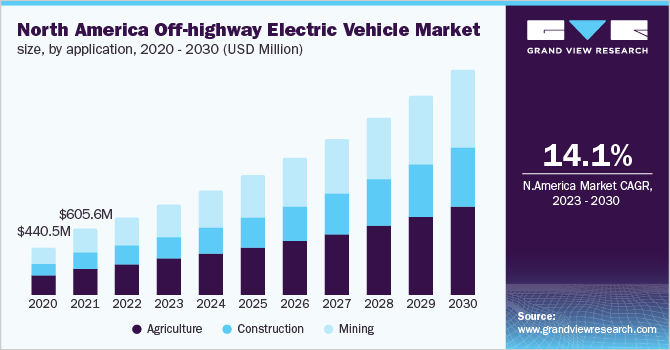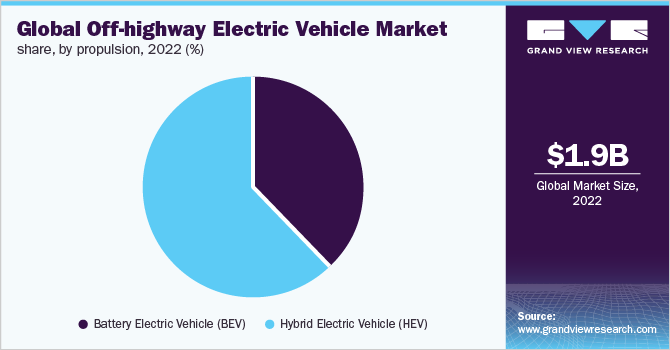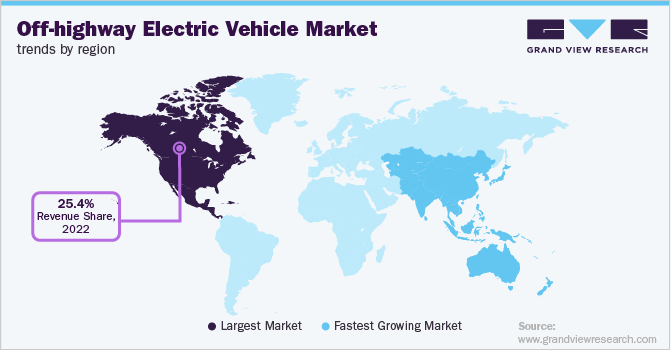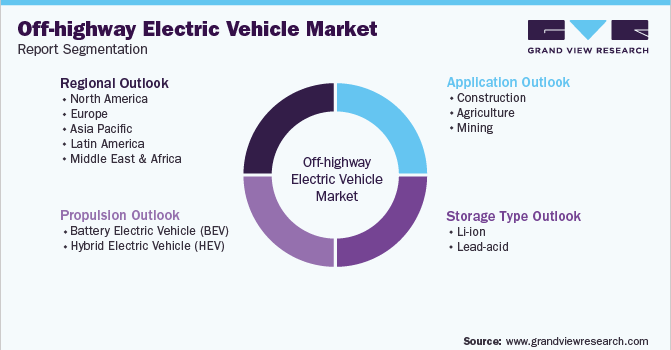- Home
- »
- Automotive & Transportation
- »
-
Off-highway Electric Vehicle Market Size & Share Report, 2030GVR Report cover
![Off-highway Electric Vehicle Market Size, Share & Trends Report]()
Off-highway Electric Vehicle Market Size, Share & Trends Analysis Report By Application Type (Construction, Agriculture, Mining), By Propulsion (BEV, HEV), By Storage Type, By Region, And Segment Forecasts, 2023 - 2030
- Report ID: GVR-4-68039-161-1
- Number of Report Pages: 120
- Format: PDF, Horizon Databook
- Historical Range: 2018 - 2021
- Forecast Period: 2023 - 2030
- Industry: Technology
Report Overview
The global off-highway electric vehicle market size was valued at USD 1,964.4 million in 2022 and is expected to expand at a compound annual growth rate (CAGR) of 14.1% from 2023 to 2030. Various government organizations have established strict emission standards for off-road vehicles, such as the China VI and India BS-VI emission standards. The U.S. Environmental Protection Agency (EPA) also placed restrictions on greenhouse gas (GHG) emissions. As a result, market growth has been fueled by equipment makers concentrating on alternative engine options such as full and hybrid off-highway electric vehicles.

The electrification of off-highway heavy-duty vehicles is increasing, and OEMs are keen to discover how this new trend can complement their existing business models. With factors such as battery technology, supply, and overall economics favoring electric vehicles, the trend of electrification of vehicles is expected to gain traction in the coming years. Charging infrastructure, battery technology, and total development cost play a significant role in the adoption of electric solutions. The electrification of off-highway vehicles assures long-term cost savings owing to lesser maintenance and reduced fuel consumption as compared to conventional vehicles.
Rapid growth in Environmental, Social & Governance (ESG) investing, which uses environmental, social, and governance criteria, promotes the development of off-highway electric vehicles for construction and mining applications. Stringent emission norms restrict the emission of Nitrogen Oxide (NOx) and particulate matter. To reduce such emissions, off-highway vehicle manufacturers are developing innovative ways to accomplish zero emission.
According to Construct Connect, the construction industry is responsible for at least 11% of CO2 emissions. The European Union (EU) established a stage 5 emissions standard, which came into effect in 2019. Since European emission norms keep evolving, equipment powered by diesel engines are likely to be discontinued in the future. Electric alternatives for such equipment in mining and construction applications are expected to drive the demand for off-highway electric equipment.
The world economy witnessed a setback due to the COVID-19 pandemic. Lockdowns implemented in various parts of the world led to disruptions in the supply chains and a temporary ceasing of production at several production facilities. The off-highway electric vehicle industry remained most vulnerable during the pandemic owing to its dependency on global sourcing for its fundamental technology, batteries.
Europe, one of the most prominent regions in the acceptance of off-highway electric vehicles, is witnessing a sharp decline in equipment sales. In April 2020, Europe’s forestry and agricultural machinery production decreased by around 10%. Moreover, new orders for construction machinery in the U.S. reduced by approximately 12% in April 2020 compared to the previous year.
Application Insights
The agriculture segment accounted for the largest revenue share of around 24% in 2022 in the global off-highway electric vehicle market. The segment includes electric harvesters and electric tractors. To increase yields, consumers in North America and Europe are utilizing contemporary farm machinery and advanced agricultural techniques. Electrification of farming equipment can also leverage automation to help overcome labor challenges, enabling laborers to concentrate on other important tasks.
The construction segment is anticipated to register CAGR of 13.9% during the forecast period. The segment includes electric construction equipment such as electric excavators and electric loaders. Increasing investments by governments worldwide in developing public infrastructure is one of the primary factors driving the growth of the segment, ultimately supporting the growth of the market. The electrification of smaller types of equipment is the focus of the construction sector. The battery technology and electric propulsion are well-suited to smaller machines owing to lower power demands.
Propulsion Insights
The Hybrid Electric Vehicle (HEV) segment accounted for the largest revenue share of 56% in 2022 and is anticipated to dominate the market from 2023 to 2030. The hybrid electric vehicle is designed to augment the use of the internal combustion engine in collaboration with the electric powertrain. The demand for hybrid propulsion off-highway equipment has increased due to strict emission standards set by regulatory bodies like the U.S. EPA and the European Commission. This has prompted automakers to create environmentally friendly off-highway vehicles.
Since 2017, off-highway vehicle manufacturers have been adopting hybrid engines featuring diesel-electric propulsion systems. These diesel-electric hybrid drive systems enable engine down speeding, allowing users to run a smaller engine at a lower rpm and, thereby, providing fewer parts movement and high fuel efficiency. All these factors are expected to contribute to the growth of the hybrid electric vehicle segment predominantly supporting the growth of the off-highway electric vehicle industry.

The BEV segment is projected to register the highest CAGR of 21.0% from 2023 to 2030 in the off-highway electric vehicle industry. The growth of the segment can be attributed to the restrictions on CO2 emission and the slowdown in the adoption of Internal Combustion Engine (ICE) vehicles. However, most off-highway vehicles require high power to function, thus the use of BEV is still limited. The advancements in battery technology and reduction in lithium-ion battery prices are expected to drive the demand for BEVs over the forecast period.
Regional Insights
North America accounted for the largest revenue share of 25.4% in 2022 and is anticipated to continue its dominance during the forecast period. The growth can be attributed to the presence of key companies such as Deere & Company, CNH Industrial N.V., and Caterpillar in North America. Moreover, the growth of the construction industry in the region is further driving the demand for off-highway electric equipment.
The U.S. has implemented strict regulations for curbing harmful emissions. According to the United States Environment Protection Agency (EPA), in 2018, nearly 30% of all greenhouse gas emissions came from off-road vehicles and equipment. Due to rising GHG emissions, companies have introduced electric versions of their off-highway vehicles in the market.

The Asia Pacific region is projected to register the highest CAGR of 14.9% from 2023 to 2030. Countries such as India and China recorded a strong performance in 2020 owing to a boost in infrastructure investments. Due to its large number of OEMs, affordable labor, cheap production costs, and superior manufacturing facilities, China is a significant contributor to the production of construction equipment.
Key Companies & Market Share Insights
Key players operating in the off-highway electric vehicle industry offer a wide range of electrically-propelled off-highway vehicles for agriculture, construction, and mining applications. They are focused on providing advanced and technologically-driven equipment to reduce the carbon footprint and adhere to emission regulations.
Major strategies adopted by the key players adopt new product launches and the expansion of product portfolios. For instance, in July 2021, Komatsu Ltd. announced the launch of an exclusively remote-controlled and fully electric (non-hydraulic drive) mini excavator. It is a fully electric 3-ton class excavator powered by a lithium-ion battery.
The industry players are also focused on consolidating their market shares by undertaking M&A activities. For instance, in June 2021, Caterpillar Inc. announced a strategic collaboration with Nouveau Monde Graphite Inc. With this collaboration, Caterpillar Inc. planned to develop, test, and manufacture Cat zero-emission machines for the Matawinie graphite mine.Some prominent players in the global off-highway electric vehicle market include:
-
Caterpillar
-
Volvo Construction Equipment AB
-
Komatsu Ltd.
-
Deere & Company
-
Sandvik AB
-
Hitachi Construction Machinery Co., Ltd.
-
Epiroc AB
-
Doosan Corporation
-
J C Bamford Excavators Ltd.
-
CNH Industrial N.V.
Off-Highway Electric Vehicle Market Report Scope
Report Attribute
Details
Market size value in 2023
USD 2,638.6 million
Revenue forecast in 2030
USD 5,745.9 million
Growth rate
CAGR of 14.1% from 2023 to 2030
Base year for estimation
2022
Historical data
2018 - 2021
Forecast period
2023 - 2030
Quantitative units
Revenue in USD million and CAGR from 2023 to 2030
Report coverage
Revenue forecast, company ranking, competitive landscape, growth factors, trends
Segments covered
Application, propulsion, storage type, region
Regional scope
North America; Europe; Asia Pacific; Latin America; MEA
Country scope
U.S.; Canada; Germany; U.K.; France; China; Japan; India; Mexico; Brazil
Key companies profiled
Caterpillar; Volvo Construction Equipment AB; Komatsu Ltd.; Deere & Company; Sandvik AB; Hitachi Construction Machinery Co., Ltd.; Epiroc AB; Doosan Corporation; J C Bamford Excavators Ltd.; CNH Industrial N.V.
Customization scope
Free report customization (equivalent to up to 8 analysts’ working days) with purchase. Addition or alteration to country, regional, and segment scope.
Pricing and purchase options
Avail customized purchase options to meet your exact research needs. Explore purchase options
Global Off-Highway Electric Vehicle Market Segmentation
The report forecasts revenue growth at global, regional, and country levels and provides an analysis of the latest industry trends in each of the sub-segments from 2018 to 2030. For this study, Grand View Research has segmented the global off-highway electric vehicle market report based on application, propulsion, storage, and region:

-
Application Outlook (Revenue, USD Million, 2018 - 2030)
-
Construction
-
Agriculture
-
Mining
-
-
Propulsion Outlook (Revenue, USD Million, 2018 - 2030)
-
Battery Electric Vehicle (BEV)
-
Hybrid Electric Vehicle (HEV)
-
-
Storage Type Outlook (Revenue, USD Million, 2018 - 2030)
-
Li-ion
-
Lead-acid
-
-
Regional Outlook (Revenue, USD Million, 2018 - 2030)
-
North America
-
U.S.
-
Canada
-
-
Europe
-
Germany
-
U.K.
-
France
-
Rest of Europe
-
-
Asia Pacific
-
China
-
Japan
-
India
-
Rest of Asia Pacific
-
-
Latin America
-
Mexico
-
Brazil
-
Rest of Latin America
-
-
Middle East and Africa
-
Frequently Asked Questions About This Report
b. The global off-highway electric vehicle market size was estimated at USD 1,964.41 million in 2022 and is expected to reach USD 2,638.6 million in 2023.
b. Some key players operating in the off-highway electric vehicle market include Caterpillar, Volvo Construction Equipment AB, Komatsu Ltd., Deere & Company, Sandvik AB.
b. Key factors that are driving the off-highway electric vehicle market growth include increasing stringency in the emission standards for off-highway vehicles, improved efficiency, and high cost of ventilation of diesel emissions in mining.
b. The global off-highway electric vehicle market is expected to grow at a compound annual growth rate of 14.1% from 2023 to 2030 to reach USD 5,745.9 million by 2030.
b. North America dominated the off-highway electric vehicle market with a share of 42.0% in 2022. This is attributable to the presence of key companies such as Caterpillar, Deere & Company, CNH Industrial N.V., among others.
Share this report with your colleague or friend.
![gvr icn]()
NEED A CUSTOM REPORT?
We can customize every report - free of charge - including purchasing stand-alone sections or country-level reports, as well as offer affordable discounts for start-ups & universities. Contact us now
![Certified Icon]()
We are GDPR and CCPA compliant! Your transaction & personal information is safe and secure. For more details, please read our privacy policy.
We are committed towards customer satisfaction, and quality service.
"The quality of research they have done for us has been excellent."





